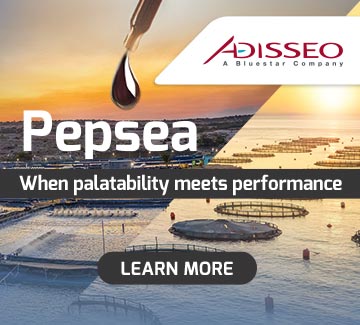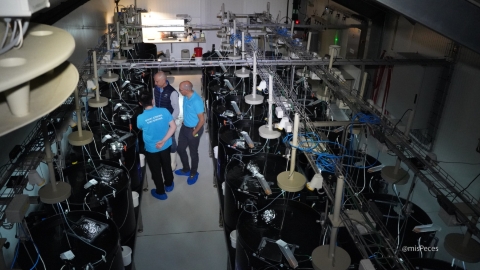
As Mediterranean species such as gilthead seabream and European seabass reach higher production volumes, research has increasingly focused on optimising resources to enhance productivity and improve feed conversion efficiency.
One of the most promising approaches in recent years has been the inclusion of marine peptides in fish diets. These peptides, derived from protein hydrolysis, are highly digestible, helping to improve feed intake and fish growth by supplying essential amino acids and bioactive nutrients that stimulate metabolism.
Among the research presented last week at the Aqua 2024 conference, in Copenhagen, Denmark, the study led by Rocío Robles Arozarena and her team at Testing Blue SL stood out. They investigated the effects of different degrees of hydrolysis and inclusion levels of a marine peptide concentrate, Pepsea®, in the diets of juvenile gilthead seabream.
The trial evaluated six diets for seabream juveniles with an average weight of 11 grams. This included a control diet without peptide concentrate and five diets with varying levels of Pepsea® concentrate and degrees of hydrolysis. The fish were distributed across 24 tanks in a recirculating aquaculture system (RAS) maintained at 21°C.
The diet containing Pepsea® delivered the best performance, outperforming other diets. Specifically, feed intake was 17% higher, the specific growth rate (SGR) increased by 21%, and the feed conversion ratio (FCR) improved by 30% compared to the control diet.
In a subsequent trial, the researchers determined the optimal inclusion level of Pepsea®. Data from this experiment demonstrated that the diet with 0.7% Pepsea® provided the best results, achieving a 4% increase in feed intake and a 3% improvement in SGR.
Additionally, feed intake, SGR, and FCR in this group were comparable to those obtained with a commercial salmon hydrolysate diet. This suggests that even with a low inclusion rate, the concentrate is effective in enhancing performance.
Based on these findings, the researchers concluded that marine peptide concentrates play a strategic role in aquafeed formulations, with specific degrees of hydrolysis and optimal inclusion levels proving essential for juvenile gilthead seabream diets.
This research is particularly significant in the current context, where optimising aquafeed formulations not only boosts productivity but also enhances sustainability by reducing reliance on costlier or less sustainable ingredients, such as fishmeal and fish oil.
By demonstrating that the strategic use of marine peptides can improve feed conversion and growth rates, this work provides a solid scientific foundation for feed formulators to adopt these innovations in commercial aquaculture.


